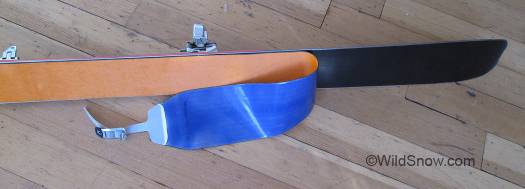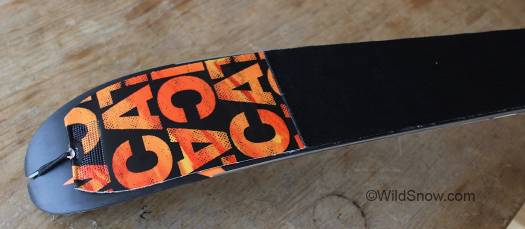It’s definitely the time of the climbing skins. Not a week goes by that we don’t get at least one inquiry about trying something new, with the common result of another carpet added to the rug pile. I’d do an overall ski touring climbing skin comparo, but things are changing so fast that the logistics required for that would be obnoxious. So I’ll hit the highlights in a few blog posts this spring.

Montana Montasprint mohair at top, comparo with High Trails full nylon at bottom.
Above was an interesting comparison showing just how apples to oranges you can get with climbing skins. I hear a lot of PR jabber about various companies making nylon climbing skins with adequate glide. Well, I’m here to tell you that in my experience NO nylon climbing skin has good enough glide for efficient touring on wider backcountry skis. For example… I cut a set of Montana Montasprint 100% mohair and a pair of High Trails Evotech Synt Plus, both for my Wailer 99 Tour 1 test planks. After a few thousand vert I didn’t need any more torture. Compared to the mohair the High Trails felt like brillo, and weirdly enough I didn’t notice any difference in grip.
To be fair to High Trails, they also make a 60/40 mohair/nylon mix that Lisa is using on her Wailer 112s, with adequate glide though again 100% mohair would be preferred.
Yes, the mohair will wear in and gain even more glide, while the nylon will gain more grip as it wears (and less glide). It’s also said by some folks in the industry that mohair could become scarce and more expensive due to the boom in ski touring. Thus, let’s hope the boffins figure out how to make nylon skins that glide — or pity the poor bald goats.
(Mohair trick: The edges are usually where you get wear that affects your grip while touring. When the mohair on your wider skis becomes worn, recut for the narrower skis in your quiver.)
Oh, and about the adhesive? Yes Virginia, the High Trails have a “glueless” stickum that’s quite tacky. It’s terrific for one-lap treks, especially fitness uphilling. Problem is this type of adhesive is ultra sensitive to moisture and cold powder snow. Contaminate the skin with either form of water, and you may have difficulty keeping the fur on your skis. Water can be squeegeed or otherwise dried off, but cold snow is difficult as you can’t scrape the glueless skins on your ski edges as with conventional adhesive (doing so can damage the adhesive).
As for the Montana skins, they use a conventional glue that I found average, with the typical problem you find in the case of much European skin stickum in that it lost tac in colder temperatures (the reason why brands such as Pomoca are attempting to sell “North American glue,” and Contour is touting their Hybrid glue technology with a wider temperature range.) I should also mention that the Montana adhesive suffers from the shoulder ripping curse inducing problem of being too tacky when stuck to itself, something the “glueless” skins totally and quite pleasantly obviate.
This is Wildsnow so we’ll mention weight. Oddly enough both the Montana and the High Trails weighed the same once cut for the skis, while the High Trails packed tighter. This is along the line of other skin weigh-ins I’ve done, leading me to not pay much attention to skin weight. Rumor is next season we’ll see some ultra-light skins hit the market. In that case the scale will get used.
Check out our previous High Trails review.

Next, we turn our attention to Kohla Vacuum Base. This is another “glueless” technology. It’s easy to handle, but again we only recommend for one-lap types of days due to issues with snow and cold. Interestingly, Kohla’s PR material says “unproblematic in cold temperatures,” but we found that to not be the case. While testing during a Colorado deep freeze in December, our Kohla skins literally fell off the skis when we picked them up to re-attach a tail clip. We were able to keep going with minimal adhesion because we were uphilling on a groomer. The situation would not have been functional in the backcountry.

In closing, here is our all-time favorite skin over the last 40 years of testing. This is an Atomic branded “Rocker Skin,” made by Contour using their Hybrid glue technology. It’s a 100% mohair carpet, with the Atomic “glide” tip as well as the skimo style tip fix. The tail is customized with a Contour Shark clip. Sticking these guys to your skis is like mounting Michelin Pilot Sport A/S 3 Y-Speed rated tires on your Tesla. Heaven!
Atomic Rocker Skins are available right now.
(Note: If you’re talking steep icy skin tracks all bets are off. Nylon plush might be better, but so too your ski crampons. Thing about mohair is if you commit to it, you learn to adjust your technique and route. )
WildSnow.com publisher emeritus and founder Lou (Louis Dawson) has a 50+ years career in climbing, backcountry skiing and ski mountaineering. He was the first person in history to ski down all 54 Colorado 14,000-foot peaks, has authored numerous books about about backcountry skiing, and has skied from the summit of Denali in Alaska, North America’s highest mountain.
